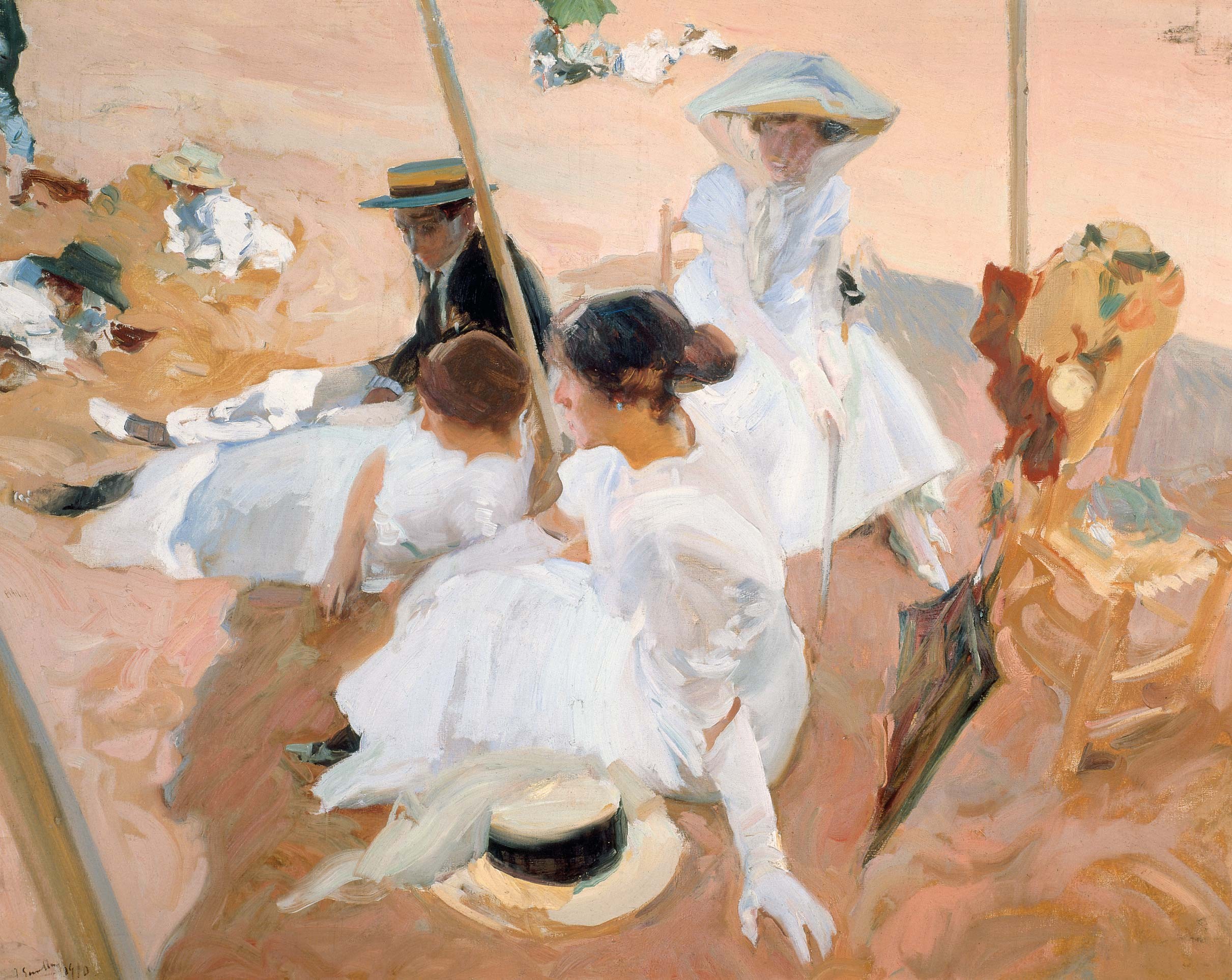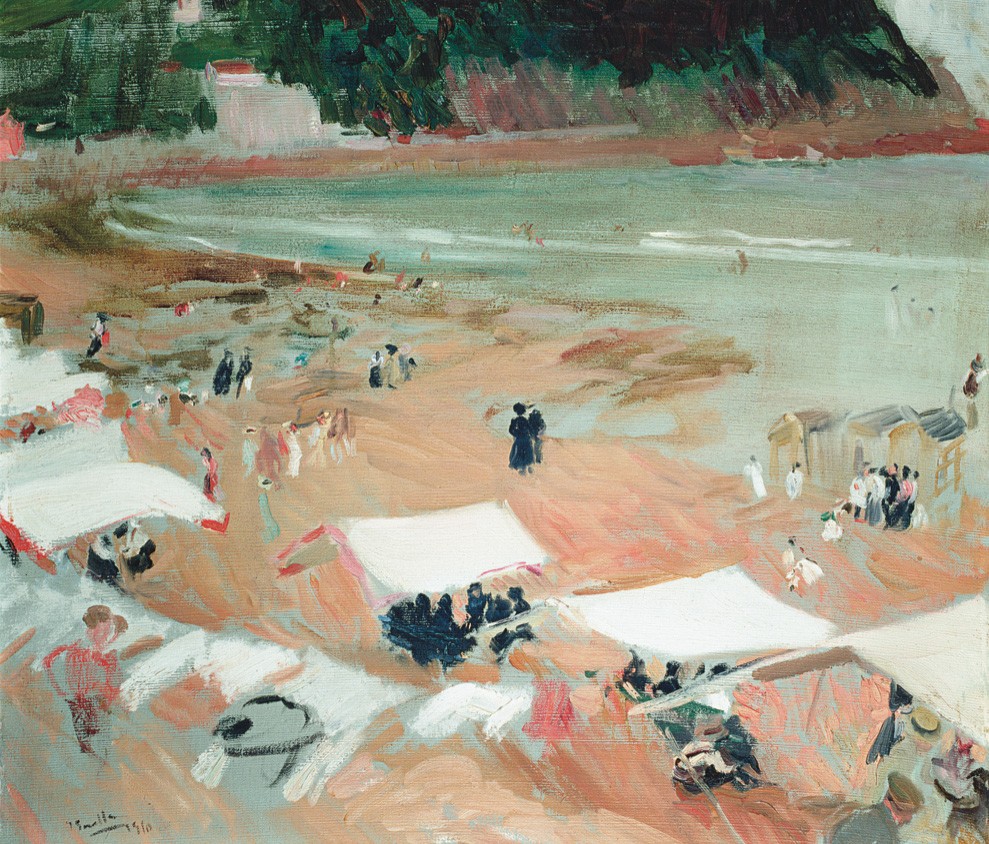Exhibitions

The guest work
Finished
2023-07-10 • 2023-10-16
Joaquín Sorolla
Under the Awning, on the Beach of Zarautz (1910)
Room 19
The feature for The Guest Work programme this summer is bringing the light-drenched works of Joaquín Sorolla (Valencia, 1863–Cercedilla, 1923) to the museum’s room 19 in the year that marks the centennial of the painter’s death. The programme is joining the celebrations with a prominent work in Sorolla’s oeuvre which he painted during one of his first campaigns in the Basque Country.
It is the work Under the Awning, on the Beach of Zarautz (1910), a key work in understanding the artist’s sojourns in the Basque lands. This painting shows the painter’s family—his wife Clotilde and his children María, Elena and Joaquín—elegantly dressed and in the shade of one of the characteristic awnings on the beach in this town in Guipúzcoa.
In around 1900, Sorolla began to painting the northern beaches, which at that time were popular among the royal family and aristocrats. This elegant summer stay enabled him to depict scenes of refined leisure with new colours that matched the northern light, which differs so starkly from the beaches of his birthplace, Valencia. In 1909, he exhibited these works in New York, and encouraged by his success, in the summer of 1910 he and his family travelled to Zarautz, the summer home of Queen Isabel II.
This painting is also displayed contextualised by another work that depicts a scenic view of the beach and four preparatory drawings of the figures. Finally, a period image of Sorolla painting outdoors draws attention to the importance of photography in his paintings, which was rooted in the close relationship he had with his father-in-law, Antonio García, one of the most prestigious professional photographers in Spain at that time.
Sorolla in the Basque Country
Joaquín Sorolla got to know the Basque Country in 1889, on his journey back from Rome, where he had mingled with the colony of Basque artists living there, and after a stop in Paris, he lived in San Sebastián for a few days. From then until 1910, once again on his way to Paris, he often made brief stops in the Basque Country which he used to take notes and paint small works, where he discovered the moist light of the Cantabrian Coast and its colours, dominated by greens and greys.
Furthermore, after Queen Isabel II’s summers in Zarautz, the northern beaches became the preferred spot of the royal family, the aristocracy and the haute bourgeoisie, such that along with the new painting motifs that the elegant summer community there provided him, Sorolla also found many clients eager to see and purchase his works. After that, the painter returned to the Basque Country numerous times, almost always with his family.
In the summer of 1906, the family moved to Biarritz and San Sebastián so that Sorolla could paint beaches and coastal scenes. In 1910, they moved for yet another painting campaign to Zarautz, where he painted his family on the beach in a series of works that reveal his outstanding skill as a portraitist. But because of the poor weather, he was also forced to paint genre scenes, like the interiors of taverns with fishermen drinking, which more closely resemble seventeenth-century realist painting.
In 1911, he summered in San Sebastián for the first time after returning from Saint Louis and Chicago, where the Hispanic Society of New York had very successfully organised his second travelling show. In 1912, he spent the first half of June in Biarritz painting the portraits of Archer M. Huntington, the founder of the Hispanic Society of America in New York, and his wife. The rest of the summer he spent in San Sebastián, from which he travelled to make studies of the archetypes of Roncal for the panel devoted to Navarra that he was painting for the Hispanic Society. During the first half of September that same year, he also painted in the town of Lekeitio (Bizkaia).
In September 1913, he again travelled to San Sebastián to meet with King Alphonse XIII. In 1914, he went back with his family to complete the painting of the Basque Country—Guipuzcoa: Bowling—for the Hispanic Society. In 1917 he spent the summer with his family in Villa Sorolla, located on the lighthouse road in San Sebastián at the base of Mount Igueldo. He moved there again the next summer, when he took notes and painted beach scenes and the city surroundings, along with around twenty works with loose brushstrokes with the Mount Ulía breakwater in the background.
In the summers of 1920 and 1921, quite ill by then, Sorolla’s family moved him to Villa Sorolla. Those were the last years before he died in 1923 in the house of his daughter María in Cercedilla (Madrid).
Joaquín Sorolla (Valencia, 1863-Cercedilla, 1923)
Bajo el toldo, Playa de Zarauz, 1910
Óleo sobre lienzo, 99 x 126 cm
Colección Museo Sorolla, Madrid
La estancia de Sorolla en Zarautz –junto con San Sebastián, uno de los destinos más cosmopolitas de la época– en el verano de 1910 se considera clave para entender su actividad en el País Vasco. Bajo el toldo, Playa de Zarauz es buen ejemplo de ello y permite vislumbrar la influencia que ejerció su autor en el entorno cultural del norte, donde se convirtió en una figura referencial. Con pincelada jugosa y rápida, Sorolla retrata a su familia bajo un toldo que, si bien no figura en la imagen, proyecta una amplia sombra que activa lumínicamente la escena en diferentes espectros. El carácter abocetado de la pintura y el estudiado encuadre componen esta elegante aunque informal escena playera.

Joaquín Sorolla (Valencia, 1863-Cercedilla, 1923)
Playa de Zarauz, 1910
Óleo sobre lienzo, 68 x 78,5 cm
Colección Museo Sorolla, Madrid
A mediados del siglo XIX la localidad guipuzcoana de Zarautz se había convertido en un enclave privilegiado en el que disfrutar de los baños de sol y mar. La extensión de su arenal, la belleza de su biotopo y el clima propicio le valieron el título de “la reina de las playas” y hasta allí se trasladaban cada año, desde que lo hiciera Isabel II, numerosos veraneantes. Este lienzo muestra la vista entre el Palacio de Narros y el monte San Antón de la vecina Getaria, llamado, por su forma, “el ratón”. La instantaneidad de la escena, obtenida mediante una pincelada enérgica y abocetada, refleja a la perfección la actividad playera, con sus relucientes toldos y el trasiego de paseantes y bañistas.

Joaquín Sorolla (Valencia, 1863-Cercedilla, 1923)
Figura femenina en la arena, 1910
Figura con sombrero en la arena, Zarauz, 1910
Grupo de mujeres en la arena, 1910
Figura tumbada en la arena y perfil, 1910
Lápiz compuesto sobre papel continuo
Fundación Museo Sorolla, Madrid
Además de su extenso trabajo pictórico, el corpus artístico de Sorolla lo componen los numerosos estudios y bocetos resultantes de su efervescencia creativa: pequeñas notas de color y esquemáticos dibujos que recogen las escenas, detalles, poses o figuras que captaban la atención del artista. Tomados directamente del natural tanto en grandes libretas y cuadernos como en hojas sueltas, Sorolla concebía estos apuntes rápidos como ejercicios de impresiones, aunque en ocasiones se valía de ellos para la realización de lienzos más elaborados, como pudo suceder con estos cuatro dibujos de figuras femeninas obtenidos en la playa de Zarautz.




Talleres fotográficos Amer
Joaquín Sorolla pintando en Zarauz, 1910
Positivo antiguo, 14 x 9 cm
Colección Museo Sorolla, Madrid

Organizer/s:

Collaborator:

